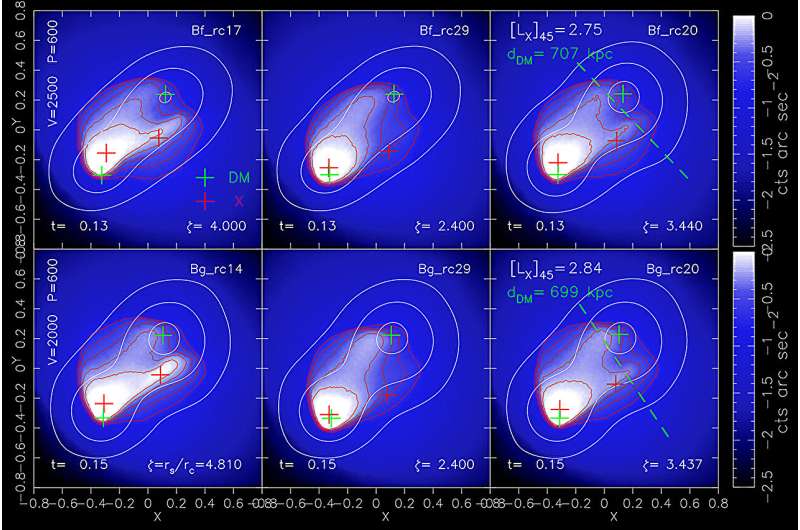This article has been reviewed according to Science X's editorial process and policies. Editors have highlighted the following attributes while ensuring the content's credibility:
fact-checked
peer-reviewed publication
trusted source
proofread
News from 'El Gordo': Study suggests dark matter may have collisional properties after all

Contrary to what is established by the standard model, dark matter may indeed be self-interacting. This was the conclusion of a piece of research published in Astronomy & Astrophysics and conducted by Riccardo Valdarnini of SISSA's Astrophysics and Cosmology group. Using numerical simulations, the study analyzed what happens inside "El Gordo" (literally "The Fat One" in Spanish), a giant cluster merger seven billion light years away from us.
The calculations indicated that in this cluster the observed physical separation between the points of maximum density of Dark Matter and those of the other mass components can be explained using the so-called SIDM (Self-Interacting dark matter) model, as opposed to the standard one. This research makes an important contribution in favor of the SIDM model, according to which dark matter particles exchange energy through collisions, with interesting astrophysical repercussions.
'El Gordo': A gigantic cosmic structure for the study of dark matter
"According to the currently-accepted standard cosmological model, the present baryonic matter density of the universe can account for only 10% of its total matter content. The remaining 90% is in the form of Dark Matter," explains Valdarnini, author of the research.
"It is generally thought that this matter is non baryonic and made of cold collisionless particles, which respond only to gravity. Hence the name 'Cold Dark Matter' (CDM). However, there are still a number of observations which have not yet been explained using the standard model," says the researcher. "To answer these questions, several authors suggest an alternative model, called SIDM."
Proving the collisional properties of dark matter and, more generally, alternative theories to the standard cosmological model one, is very complicated. He explains, "There are, however, unique laboratories that can prove very useful for this purpose, many light years away from us. These are the massive galaxy clusters, gigantic cosmic structures that, upon collision, determine the most energetic events since the Big Bang.
"With a mass of about 1015 solar masses, El Gordo is one of the largest galaxy clusters we know. Due to its peculiarities, El Gordo has been the subject of numerous studies, both theoretical and observational."
Dark matter could be collisional
According to the standard paradigm, during a cluster merger the behavior of the collisional gas mass component will differ from that of the other two components—galaxies and dark matter. In this scenario, the gas will dissipate part of its initial energy.
"This is why, after the collision, the peak of gas mass density will lag behind those of dark matter and galaxies," explains Valdarnini. With the SIDM model, however, a peculiar phenomenon should be observed, namely the physical separation of dark matter centroids—its maximum density points—from those of other mass components with peculiarities that represent a true "Signature of SIDM models." According to observations, this is exactly what happens inside "El Gordo."
Observing El Gordo
"Let us start with observations," explains Valdarnini. El Gordo consists of two massive subclusters, respectively denominated northwestern (NW) and southeastern (SE). The X-ray image of the "El Gordo" cluster shows a single X-ray emission peak in the SE subcluster and two faint tails elongated beyond the X-ray peak. A noteworthy feature is the peak location of the different mass components.
At variance with what can be seen in the Bullet Cluster, another important example of a colliding cluster, the X-ray peak precedes the SE dark matter peak. Moreover, the Brightest Cluster Galaxy (BCG) is not only trailing the X-ray peak, but it also appears to be spatially offset from the SE mass centroid. Another notable aspect can be seen in the NW cluster, where the galaxy number density peak is spatially offset from the corresponding mass peak.
Research findings suggest Collisional Dark Matter as an explanation for the phenomena observed in 'El Gordo'
In order to explain his findings and validate the SIDM models, Valdarnini used a large set of so-called N-body/hydrodynamical simulations. Thus, he carried out a systematic study aimed at reproducing the observational features of "El Gordo."
"The most significant result of this simulation study is that the relative separations observed between the different mass centroids of the 'El Gordo' cluster are naturally explained if the dark matter is self-interacting," states Valdarnini.
"For this reason, these findings provide an unambiguous signature of a dark matter behavior that exhibits collisional properties in a very energetic high-redshift cluster collision. There are, however, inconsistencies, as the SIDM cross section values obtained from these simulations are higher than present upper limits, which are of order unity at cluster scales.
"This suggests that present SIDM models should be considered as only a low order approximation, and that the underlying physical processes that describe the interaction of dark matter in major cluster mergers are more complex than can be adequately represented by the commonly-assumed approach based on the scattering of dark matter particles.
"The study makes a compelling case for the possibility of self-interacting dark matter between colliding clusters as an alternative to the standard collisionless dark matter paradigm."
More information: R. Valdarnini, An N-body/hydrodynamical simulation study of the merging cluster El Gordo: A compelling case for self-interacting dark matter?, Astronomy & Astrophysics (2024). DOI: 10.1051/0004-6361/202348000
Journal information: Astronomy & Astrophysics
Provided by International School of Advanced Studies (SISSA)




















